With ever-increasing competition, businesses from all verticals are stumbling upon obstacles on their way while trying to stand out and grab the attention of potential buyers. Today, it is clearly not enough to merely present a useful product or service — one should also market it correctly.
The fundamental strategy of effective digital marketing requires reaching the right people at the right time in the right place. It may sound complicated from the beginning, but in fact, things get quite easy once you start using one of the most effective approaches — targeted digital advertising. Down below, we'll explore how online ad targeting works and list six best practices to include in your programmatic ads strategy.

What is targeted advertising?
Targeted advertising includes lots of approaches applicable to both online and offline channels across many verticals. The general strategy, however, is similar for all of them — the main point is to define your prospective clients and divide them into audience segments according to specific characteristics. These segments will then be targeted with personalized messages depending on their intents, online behavior, or your campaign's goals.
In life, it looks like: different users of various devices will open the same webpage but will see individual advertising. Advertising adapts automatically. But behind this lies a significant contribution of well-suited targeted advertising campaigns, and at times even involved artificial intelligence.
How does targeted advertising work?
So how does targeted ads work? Well, wonder no more! Simply put, targeted advertising uses customer data to show personalized ads, ensuring your message reaches the most relevant audience. Let’s dive into this advertising method and why it can be so effective for achieving your marketing goals.
Step # 1: Collecting data
First things first, a business has to collect (or purchase) data on its customers. This may include demographics, location, user behavior, interests, and so on.
Step # 2 Analyzing data
Once the necessary data is gathered, the next step is data evaluation. This allows marketers to create a perfect customer persona to keep it as a reference. and create precise campaigns for their perfect audience.
Step # 3 Segmenting audiences
This step is optional, however, it’s also possible to create different audience segments based on certain characteristics to adjust the messaging based on these groups.
Step # 4 Placing ads
Marketers personalize their ads and then place them on the platforms most relevant to the interests of their target audience.
Step # 5 Optimizing continuously
The optimization process is constantly ongoing, so it requires regular analysis of ad performance to identify the campaign's strengths and weaknesses and make well-informed adjustments.
Targeted advertisements segmentation
Let's look at how one brand can target users from two entirely different segments.
Imagine a business focused on producing a wide range of headphones. Their clients may have different needs and motivations while searching for a specific product, so each of these clients should be communicated with a different message.
Let's say the first segment includes active young people who prefer to listen to music while doing a workout or commuting from one place to another. Their primary interests, in this case, are portability, convenience, and durability, so both the online ad and the product should reflect their demands.
The second segment consists of huge music fans or music professionals who appreciate the quality of sound and are willing to pay more for it. In this instance, they are likely to take a look at more substantial, more sophisticated speakers, which could be less convenient and more expensive.
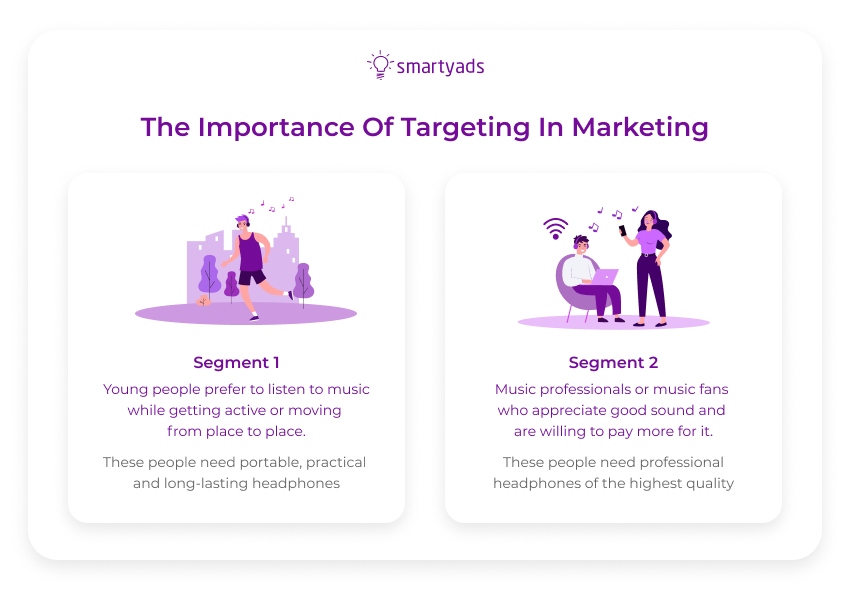
For successful targeting, ads delivered to these prospects should emphasize that the products are worthy investments. The message should convince the user that they get the quality they were looking for.
Moreover, these segments can be further divided into even more precise groups of clients; then, they can be targeted with even more personalized messages. So, in order to open up the full potential of targeted ads, you need to explore how digital audience targeting actually works.
Benefits of targeted advertising
Targeted advertising benefits are immense which is why thousands of marketing professionals opt for this effective approach when it comes to advertising. Let’s explore the main advantages it brings to the table.
High level of personalization
Targeting implies identifying and analyzing their target audience. The more accurately you segment by age, gender, geo, preferences, and habits, the more personalized ad you can deliver. Higher personalization = better chances of selling the product/service to them.
Flexibility
You can combine or exclude different targeting options to reach a set of your ideal clients. Such flexibility helps refine your audience, ensuring your ads reach the most interested individuals. It can drive engagement and enhance campaign performance.
Cost-efficiency
This advertisement approach is pretty cost-efficient. By granting your ads are shown to the most relevant audience you can significantly reduce the cost per click. This leads to better budget allocation, improving ROI, while avoiding money waste on irrelevant users.
Global reach
Targeted advertising can capture customers worldwide and, at the same time, it filters those who don't need your product. By showcasing your ads to the right customer, you increase brand awareness and maximize the impact of your ads.
 2.webp)
Types of targeted advertising
Targeted advertising is a powerful way to reach the right audience with precision. In this section, we’ll explore the various types of targeting methods that can help you enhance your campaigns and drive better results.
Geographic & demographic targeting
Demographic and geographic targeting advertising divides customers by gender, age, location, etc. All data is collected through cookies, and customers are segregated with sophisticated algorithms. These algorithms eliminate unsuitable customers outside the target audience.
Let’s give an example of a social media targeting case. If you opened a new fitness center for women, it would not make sense to show ads to men. Studies show that targeted advertising based on demographic information has a high click-through rate.
Geo targeting helps advertisers to spread geolocation ads worldwide or to show it to Internet users in regions where physical delivery of purchased goods is possible. And even more: precise top geo sometimes resembles lighthouses around various stores in a city, operating within several hundred meters.
Still, demographic and geographic targeted ads are not just about gender, age, or location. Today, big publishers like Facebook, Instagram, YouTube, and LinkedIn are masters of social media platforms' data: job position, social status, and much more.
Behavior & interest targeting
If the targeted advertising focuses on the user's browsing action, it is called behavioral targeting. This means that users will receive messages based on their typical interactions with browsers.
At first, the information is gathered from web sources (for example, third-party cookies) and stored within data-management platforms. Digital marketers gather data on browsing history and consumer behavior. The online data collection is analyzed thoroughly. Then, the potential customers are divided into segments based on their backgrounds and interests. Finally, ad personalization is created to meet their needs and reach the campaign goals.
In addition, based on typical user behavior, digital marketers conclude that users are usually active at certain times of the day. For instance, people spend more time on social media after work or at weekends. It is called time-targeted advertising.
Surely you remember certain Google ads hunting you? They were behaviorally targeted ads.
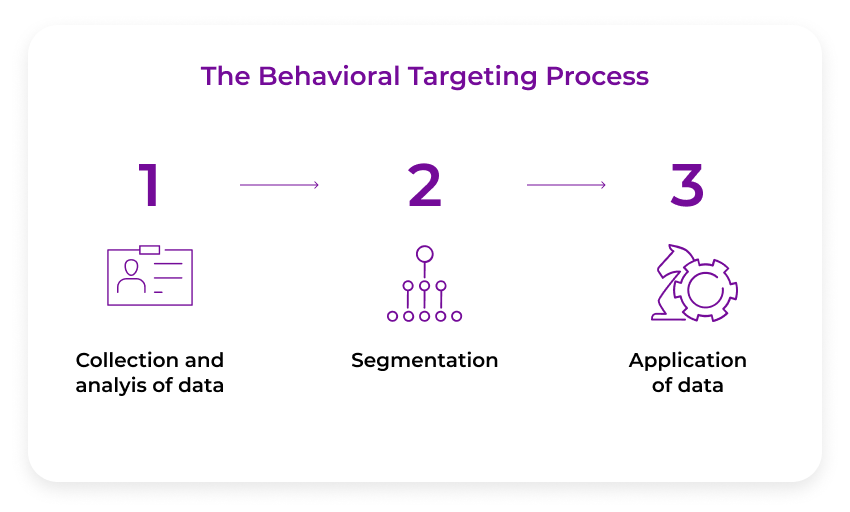
Keyword & contextual targeting
Contextual targeting means that an ad message cannot be linked to the user data; only the keyword or topic of the visitor's content currently matters. How it works:
- Crawlers closely analyze the website — every URL is scanned, and ad placements are categorized by website content;
- The ad server matches the information with personally relevant topics, keywords, and categories so that the appropriate ad can be placed.
For instance, someone reads about the morning run's benefits and sees targeted advertising for comfortable sneakers. In time!
Contextual targeting is not grounded on user data, so it is a smart solution in light of third-party cookie deprecation in the digital ad industry.
Device & platform targeting
Device & platform targeted ads are necessary when a product is only suitable for specific devices or platforms.
Undoubtedly, promoting a new game to computer users with the proper operating system is preferable. For instance, as the new app will be available on iTunes only, it will be more suitable to show it to existing iPhone customers. It explains why marketers use very detailed segmentation when it comes to technical targeted marketing and advertising.
Going deep into the technicalities will help to determine if it is possible to show the user an impressive multimedia ad or if it is preferable to limit ourselves to static ads. The main task is to let the user see the ad addressed to them, even with slow Internet. And to impress them with a more complex multimedia creative if the user's Wi-Fi is sufficiently fast.
AI-based predictive targeting
Predictive targeting involves machine learning for advanced analysis and foresight. Artificial intelligence identifies the connections between goods, sales, and users' behavior and finds those customers most willing to convert soon.
Programmatic advertising uses machine learning to automate targeting and retargeting. It helps to maintain ad relevance at the highest level and reaches maximum ad customization. Irrelevant advertising is excluded, which also results in cost savings.
If your chosen programmatic platform provides predicted targeting, AI and ML algorithms independently calculate the buying probability and the opportunity to display ads to a particular user. The demand-side platform provides this function to make the message relevant to users. But first, before choosing a DSP, it's critical to know which data your DSP uses and which segments it focuses on.
Essentially, SmartyAds DSP analyzes information about the user and matches it with targeting criteria: device, geolocation, county, city, time zone, gender, marital status, education, language, interests, and income.

6 Best practices for targeted advertising
As we can see, there is nothing complicated about launching targeted ad campaigns, even for a novice. Usually, you must sign up on the demand-side platform, create a campaign, and set up preferred online advertising targeting options. Simply including personalization in your marketing strategy will increase your campaigns' performance and overall profits. However, you can achieve even more if you also apply some of the best advertising practices.
1. Pixel your campaigns
The most fundamental thing is data. Of course, you can always purchase collected sets of data from various vendors, but from a long-term perspective, it is much better to get your insights. This will help you understand your existing audience and predict potential advertising outcomes. A convenient and straightforward way to do this is to pixel your campaigns.
Pixels are small and invisible pieces of code that can be inserted into your web pages and campaigns to gather information about your target audience. They allow you to place and read cookies that include valuable information about your visitors, such as their device type, IP address, demographics, behavior, etc.
This data can then be used on the DSP to segment your audience and launch a precisely targeted banner ad.
Once you have gathered all the necessary information, there's no need to try and guess who will see your ads — with SmartyAds DSP they will match the exact customers they can resonate with.
2. Build your audience
A straightforward yet extremely effective type of online targeting, demographic targeting remains one of the most widely used practices of targeted advertising. It usually includes basic facts about the user, such as age, gender, annual income, and many others. These characteristics can be especially useful for specific niche businesses oriented at certain demographic groups.
For example, your target audience persona could be a middle-aged male from the upper class or a senior interested in luxury goods. All these personas can be categorized on your DSP and addressed with a precise message they need to see.
Sometimes it is not enough to choose a couple of characteristics to reach the right people. You can set smart filters and find interested customers, but all these efforts would be wasted if your business only serves on the other side of the globe.
Luckily, with geo-targeting, you can easily avoid such confusion by limiting the precise geographic location of your prospects. On SmartyAds DSP, simply choose a country, city, or region you need within the first graph of the 'Targeting' settings.
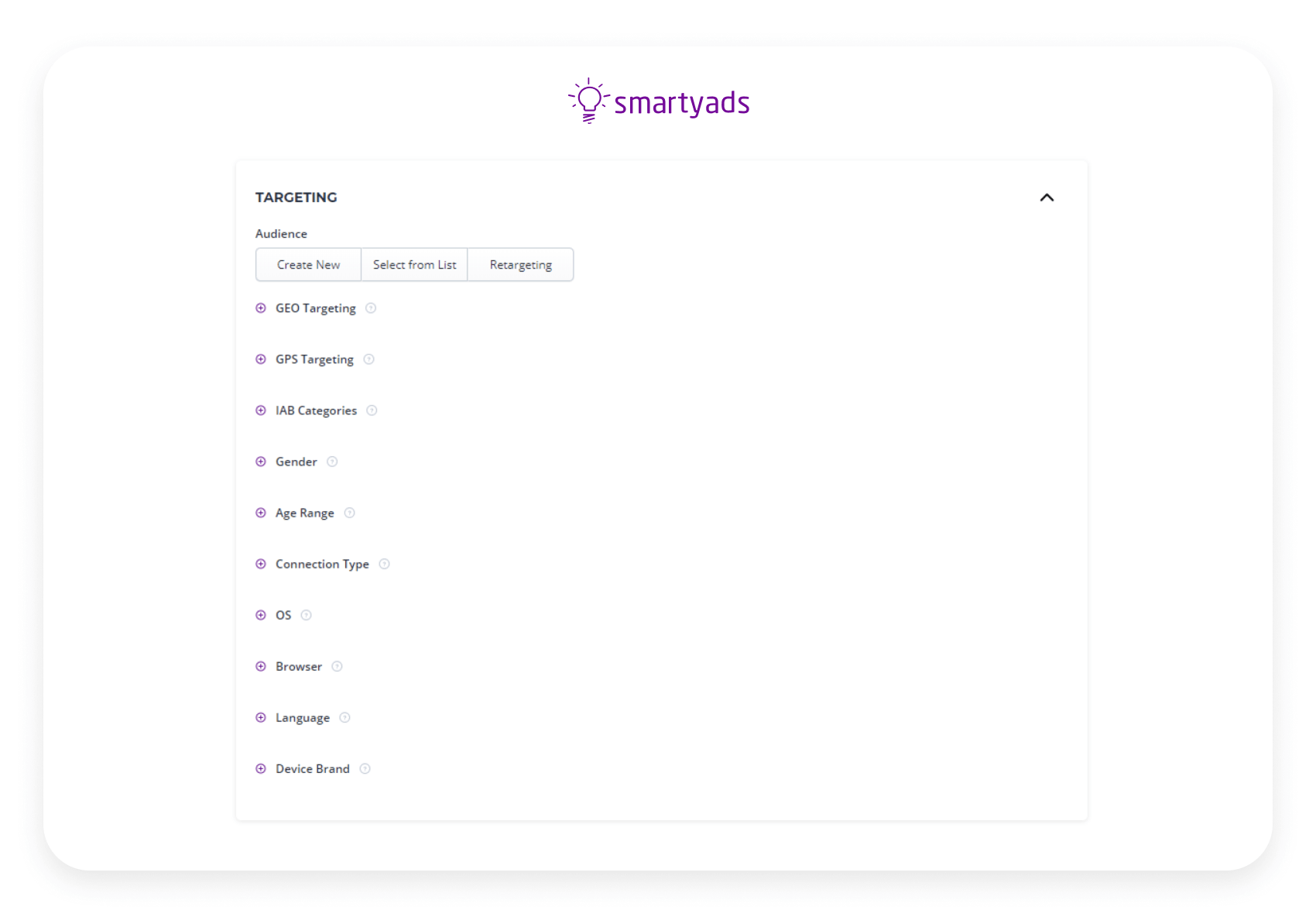
And if you need laser-like precision for your advertising campaigns, you can always turn to GPS targeting. For example, if your business provides local services in certain parts of the city, there is no need to target an entire municipality. It would be best if you chose specific places where the users are most likely to convert and send them the right message. This way, you can create hyper-local targeted ads and reach people from a certain street or district.
On SmartyAds DSP, choose the accurate GPS coordinates of the place and then pick a radius around that point. It starts at 1 km and can cover any area of your choice. You can filter by zip code or select multiple areas to diversify your choices.
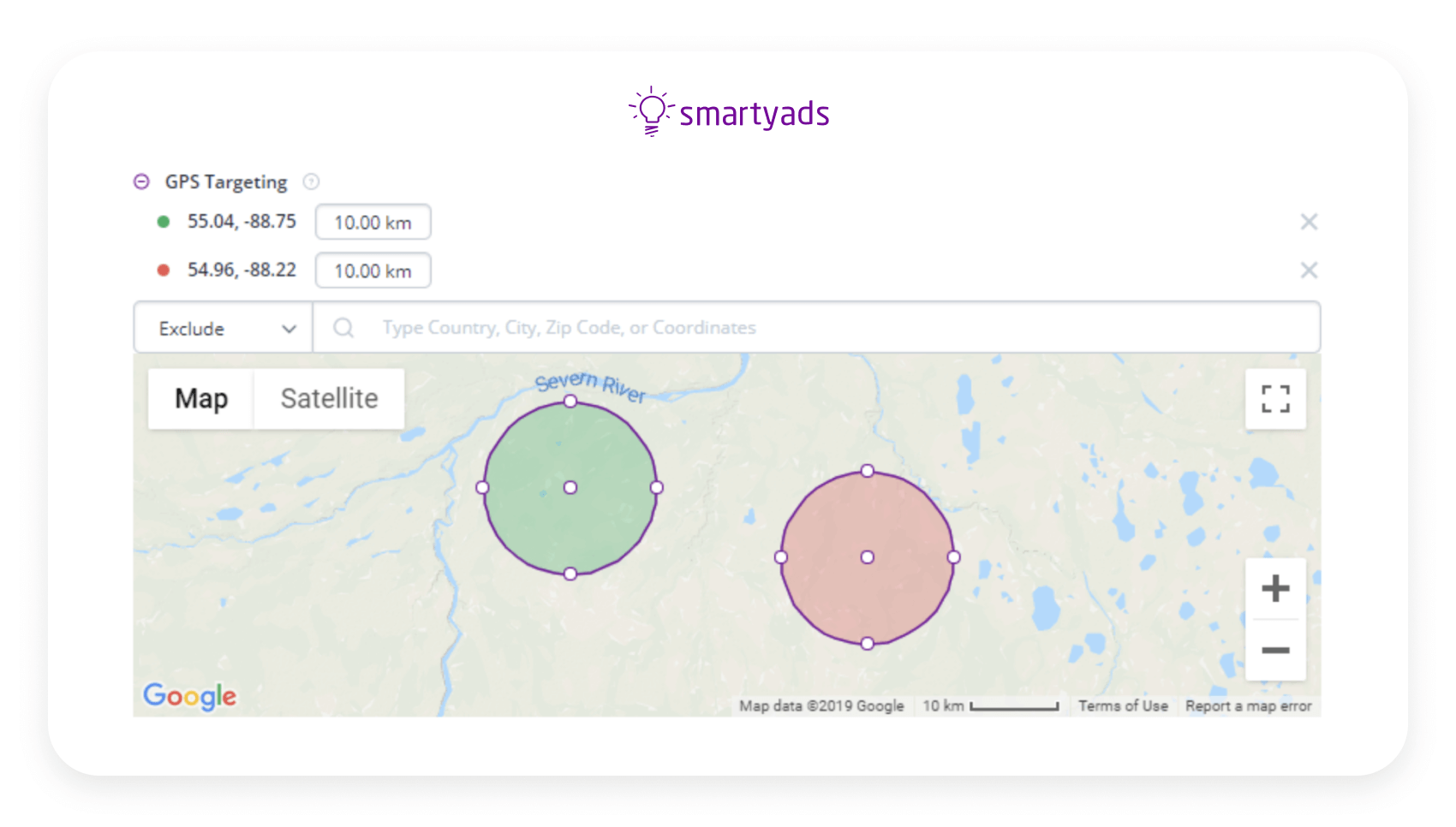
3. Use “audiences” on DSP
Once you've geared your channels in action, it is time to observe the results carefully. If your campaign is performing well, it will surely make sense to remember your best-performing settings for future campaigns and retargeting strategies.
Such categorization is also useful for brands with broad audiences that require detailed segmentation by interests, goals, and opinions. Customers of each segment can then be addressed with personalized messages regarding the product or service they'll be most interested in.
This is possible thanks to the 'Audiences' feature within our DSP. An audience is a group of users that can be collected either by your previous campaign or from website pages via pixels, conversions, or clicks. Once you've created and saved your audiences, you can then use them to reach your next marketing goals and launch targeted advertising without spending tons of time setting up new campaigns.
4. Target according to selected channels
Undoubtedly, for most campaigns in targeted online advertising, it is vital to reach your customers at the right place. But what about the online part of the customer journey? After all, for an advertising campaign, the Internet is the first place where customers encounter your message so the right channel can play even a greater role than an actual physical location.
This is especially important for building an omnichannel marketing strategy where your ads depend entirely on the channel you use. You can find that some channels are more suitable for specific business goals and creatives, so picking the right one is essential when it comes to advertising. Apart from social media, some of the most popular channels include:
Desktop
Banner ad formats, video, native and rich media — all of these can work well for a universal desktop campaign. You can reach people at home or work in almost any corner of the world. It is also the most versatile channel, as it includes the most significant number of targeted advertising sizes and formats so far.
Mobile & in-app
Smartphone usage is steadily increasing, and so is the number of opportunities for advertisers. Popular mobile ad formats include in-app, rewarded video, banner, native, and even playable ads, which give online ads lots of space for imagination and creativity.
Connected TV
Another fast-growing channel with plenty of benefits and opportunities for advertisers is CTV. On CTV, advertisers can serve a wide range of high-quality ad formats with high viewability and premium audiences. It is also an excellent choice for advertisers interested in other types of online advertising since data can enable more features for personalization.
5. Avoid hyper-targeting
To be effective, try to avoid over-limited ad targeting of your target audiences. We recommend adding a maximum of 3-4 essential customer characteristics in the beginning. Let targeted advertising be broader in scope.
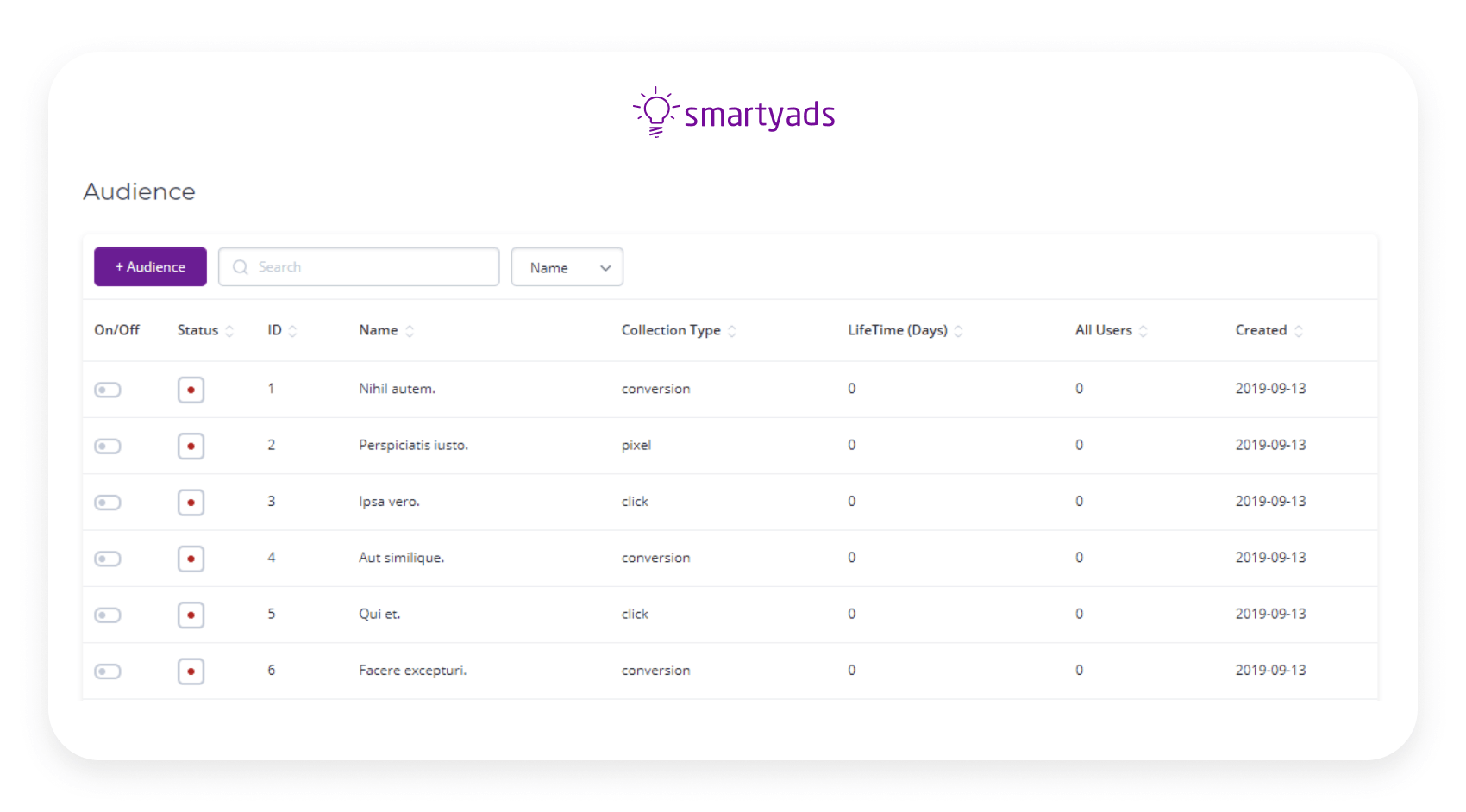
6. Make the most out of retargeting
What can be better than reaching new prospects? That's right — building a solid relationship with the returning ones! Some of your prospects may still be researching, and others — waiting for new offers. There might be numerous reasons why an interested user wouldn't convert immediately, but you can still win them back, and the key to achieving this lies in retargeting.
The possibilities are endless. You can bring back those who visited your site but haven't taken any action or abandoned the shopping cart. You can also remind your previous customers about your brand by offering them discounts or other benefits for their loyalty.
The mechanism is simple: choose "Retargeting'' on the top of the "Targeting" settings, pick one of your saved audiences, and enjoy the reunion with your previous clients. As time goes on, applying best practices in the retargeting mobile app or a site will dramatically increase your brand recognition.
Future trends in targeted ads
The landscape of advertising is evolving rapidly, with new technologies and consumer expectations shaping the future. Here are some key trends to watch:
AI and ML for hyper-personalization
Nowadays, online users are the most exigent users. They require the best digital experience, thus making hyper-personalized ads a must for you. They are so fed up with endless ads flashing before their eyes that it becomes almost impossible to get noticed in the middle of the digital clutter.
AI/ML technologies are actively used to deliver the most relevant and personalized experiences ever by predicting consumer behavior and optimizing campaigns in real time.
Contextual advertising over cookies
We all remember when Google promised a cookieless future. While they decided to continue collecting third-party cookies, for now, the industry is still gradually shifting toward contextual advertising. This approach minimizes the reliance on cookies by focusing on the context of the content users are interacting with (rather than their past behavior.)
Contextual ads are usually non-intrusive as they are relevant to the content a user is viewing online. This approach enables advertisers to deliver highly personalized and customer-friendly ads while respecting their privacy and fostering more loyal and long-lasting relationships.
AI-generated ads & dynamic creatives
AI has deeply penetrated each and every industry. AI-generated ads are becoming a game-changer for businesses with limited resources and budgets. The quality creatives can make a huge difference when delivering campaigns. Dynamic creatives can adapt to different users, demonstrating personalized visuals, messaging, and CTAs in real time.
SmartyAds is about to launch our Creative Builder — a feature that will fully transform your experience of designing creatives for your brand. Stay tuned to see the release of our Creative Builder and be the first to try it!
To sum up
Targeted advertising offers a wide range of practices and approaches applicable to most business goals and verticals. Even the most narrow-niche brands can reach their potential clients by tailoring their messages specifically to selected audience groups.
To explore its full potential, one can employ some of the best targeting practices, such as pixeling their online assets or using demographic, geographical, and behavioral targeting.
It is also useful to segment your audiences carefully and save the best-performing settings, as this can work miracles for future campaigns. Finally, don't forget about retargeting to leverage both new and old connections effectively.
Register at SmartyAds DSP to get in touch with your clients at the right time and in the right place!

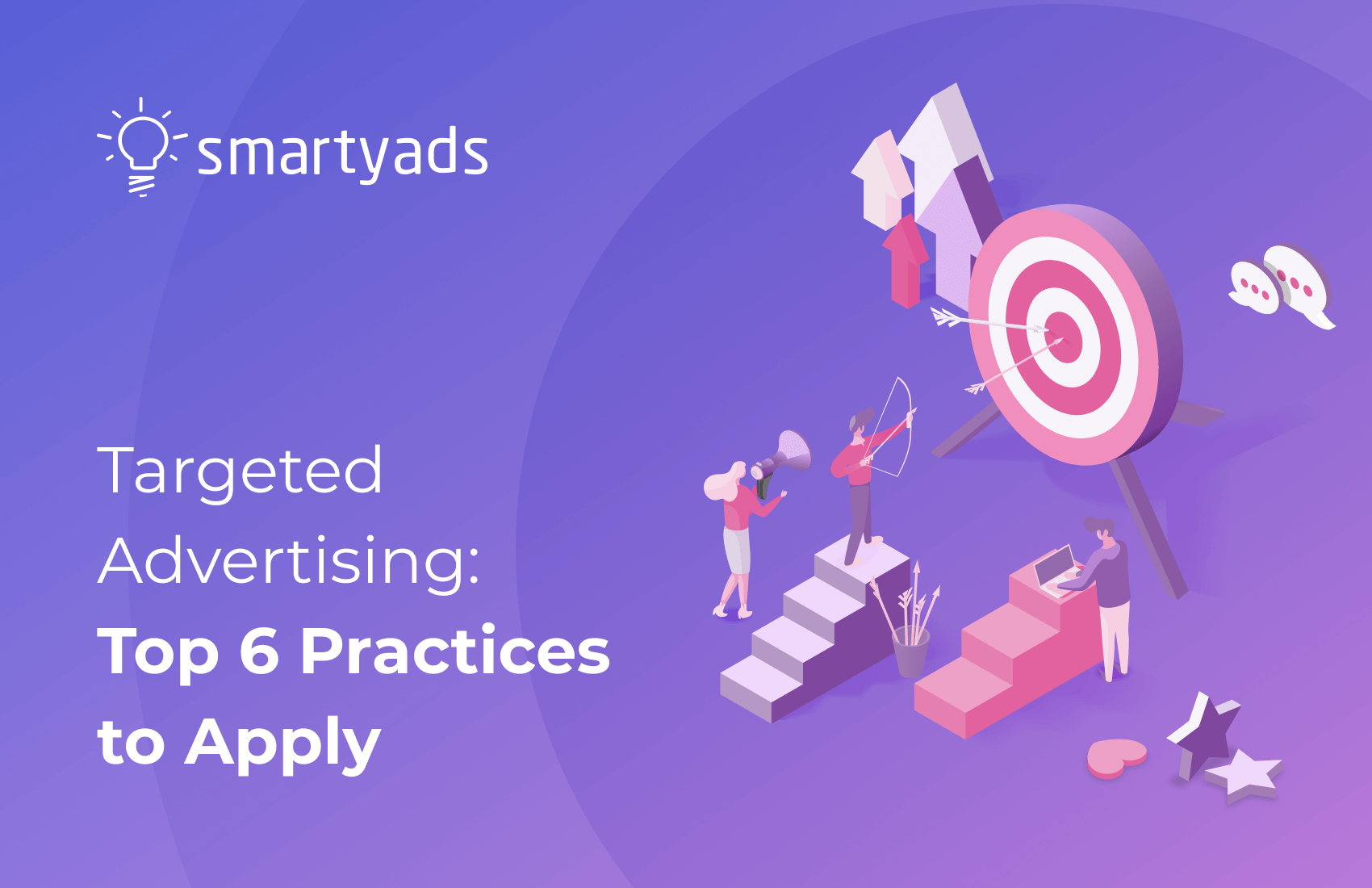
.webp)


